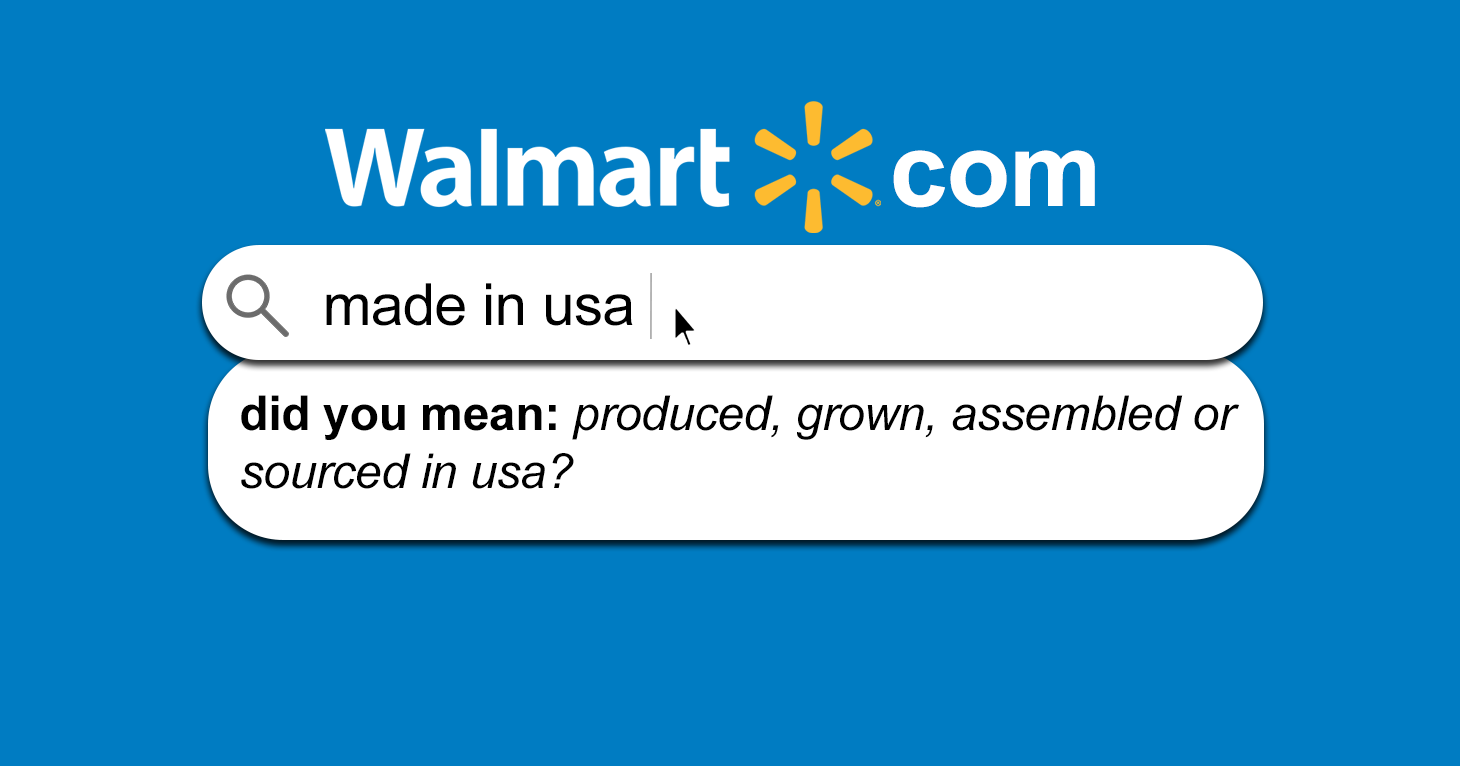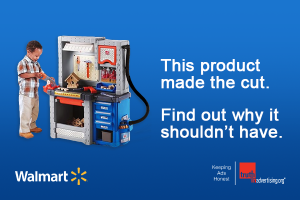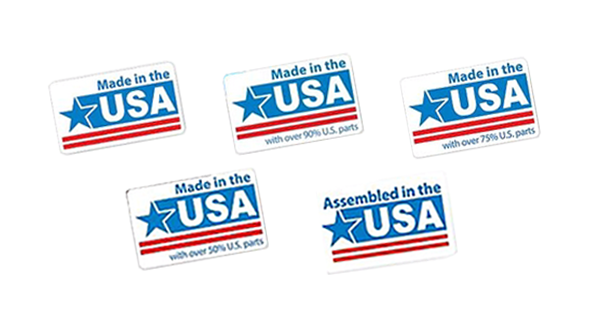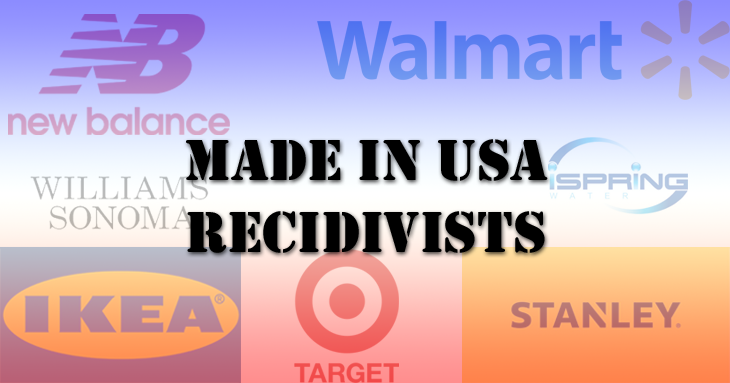
TINA.org Brings Walmart’s Deceptive Made in USA Claims to the FTC, Again
Walmart attempts to redefine what it legally means to be “made” in the USA.
TINA.org investigation finds more than 100 USA labeling errors.
|
Editor’s Note: Updates have been posted at the end of this article.
Walmart is going all out for America, pledging to buy an additional $250 billion in American products. To that end, the world’s largest retailer hosted a manufacturing summit to look for U.S.-made products to sell. The event started three days after the Fourth of July and promised to be a star-spangled affair.
But one item that probably didn’t make the agenda: The USA-made labeling mess on Walmart.com that the company has pledged to address after TINA.org brought the issue to corporate officials.
TINA.org’s investigation into the retail giant’s website readily uncovered more than 100 instances of false and deceptive U.S.-origin representations. The investigation revealed products labeled “Made in the USA” though packaging indicated they were “Made in China.” TINA.org also found USA product labels on Walmart.com that were in direct conflict with the site’s own specification information on the same webpage.
In a letter sent June 22, TINA.org called on Walmart to remove from its site all false and deceptive made in the USA representations. The company cited multiple reasons for the mislabeling issues including “coding errors,” outdated information from suppliers, and a convoluted process by which USA labels and product specifications are handled separately on the site. Walmart said TINA.org’s letter has since prompted the decision to streamline that process. In addition, Walmart spokesman Kory Lundberg said that the company relies on suppliers to submit accurate information regarding their products’ origin claims.
But while Walmart pledged that it would fix the problems, and has made limited progress in removing some of the false labels, the website is still riddled with USA labeling issues.
“False made in USA labeling on Walmart’s website has misled consumers looking to purchase American-made products,’’ said TINA.org Executive Director Bonnie Patten. “The largest retailer in the world should have made sure its American-made claims were accurate before affixing made in USA labels on the products. Until Walmart cleans up this mess, consumers cannot rely on Walmart with regard to where a product is really made when shopping on the site.”
Sold on America
 It’s no secret that patriotism sells. Not only do Americans prefer products made in the USA to those made abroad, but a recent survey found that they are willing to pay 60 percent more for American-made products.
It’s no secret that patriotism sells. Not only do Americans prefer products made in the USA to those made abroad, but a recent survey found that they are willing to pay 60 percent more for American-made products.
Walmart’s stated commitment to “American renewal” comes at a time when the company is trying to boost online sales, which lag mightily behind the more than $1 billion in sales that its brick-and-mortar business brings in every day. It has vowed to invest as much as an additional $500 million in e-commerce. And while Walmart has promised to be selective about what American-made products it chooses to bring home from the upcoming summit — posting on Twitter: “This product (My First Hot Sauce) didn’t make the cut. Find out what will on July 7th” — TINA.org found numerous products on Walmart.com that shouldn’t have “made the cut.”
The Made in America Mess
The misrepresentations found on the site can be divided into three categories; an example from each is highlighted below. (UPDATE: After receiving TINA.org’s complaint, Walmart has since made some changes to these product labels on its website.)
USA labeling that conflicts with product packaging (Equate is Walmart’s brand):
Walmart’s excuse: Supplier recently moved manufacturing from China to the U.S. but some stores may still have some of the old inventory. (After receiving TINA.org’s letter, Walmart removed the “Made in the USA” label from this product and at one point added a disclaimer to the webpage that stated, in part, “While we strive to obtain accurate product information, we cannot guarantee or ensure the accuracy, completeness or timeliness of any product information.” That disclaimer is no longer there.)
USA labeling that conflicts with specifications on the same webpage:
Walmart’s excuse: Again, supplier recently started making the product in the U.S. and the site is slow to catch up. (Walmart removed the USA label from this product after receiving TINA.org’s letter.)
Specifications on Walmart.com that conflict with product packaging:
Walmart’s excuse: The specification information comes from Almay.
While Walmart made some changes to the above examples TINA.org provided, other misrepresentations still exist on Walmart’s site.
“It’s incredibly disingenuous for Walmart to be promoting their initiative to stock $250 billion American-made products while at the same time they are in violation of FTC labeling standards for what qualifies as made in the USA,” said Michelle Amazeen, assistant professor of advertising at New Jersey’s Rider University.
Walmart spokesman Kory Lundberg said that the company relies on suppliers, like Almay, to submit accurate information regarding their products’ origin claims.
A Design Flaw for Consumers
The design of Walmart’s USA labels is also problematic. The site uses five different red, white and blue USA labels that all look identical except for hard-to-read fine print above and below “USA” (such qualifying language is especially hard to read in search results): The website does not define or point to the differences between the labels. And this leaves online shoppers who view them more confused than informed about the origin of the products, according to Dr. Jeff Johnson, a visual perception and web interface expert who reviewed Walmart’s website for TINA.org and found problems. He wrote in his report:
The website does not define or point to the differences between the labels. And this leaves online shoppers who view them more confused than informed about the origin of the products, according to Dr. Jeff Johnson, a visual perception and web interface expert who reviewed Walmart’s website for TINA.org and found problems. He wrote in his report:
The fact that the label has several variants, some meaning the same thing and some meaning different things, also compromises their intelligibility — the ability of consumers to understand what they mean. For example, even if a customer notices that products on Walmart.com can have “Made in…” or “Assembled in…” labels, they might not understand what “assembled” means compared to “made.”
Walmart said that it is going to make the qualifying language on its three percentage USA labels larger. But until Walmart completely gets its house in order, consumers should question made in the USA claims appearing on the retailer’s site.
This is the second action TINA.org has filed regarding made in the USA claims. In May, TINA.org alerted the FTC and the New York State Attorney General that Revlon’s ongoing “Almay Simply American” campaign featuring Carrie Underwood was making deceptive made in the USA claims. Almay does not disclose in its TV advertisements or on its website that more than 95 percent of its products do not meet the legal standard for American-made.
Find more of our coverage on what made in the USA really means here.
UPDATES
7/28/17: Walmart has done away with its “Important Made in USA Origin Disclaimer” that attempted to shield it from made in the USA misrepresentations on product pages. A new disclaimer states that Walmart has not verified that any product information is accurate and reiterates that consumers should rely on product packaging and manufacturer information.
In July 2015, TINA.org filed a complaint with the FTC asking it to take action regarding Walmart’s false and deceptive made in the USA representations. Three months later, the FTC said it was closing its inquiry because Walmart took several steps to prevent “consumer deception,” including removing made in the USA logos from all product listings and removing U.S.-origin claims that appeared in product descriptions or titles, but TINA.org alerted Walmart that not all misrepresentations had indeed been removed.
Walmart attempts to redefine what it legally means to be “made” in the USA.
FTC finalizes its Made in USA Labeling Rule.
1. New Balance In 1996, the FTC brought an administrative action against New Balance for making deceptive U.S.-origin claims about its sneakers. Since at least 2009, the company has marketed…

